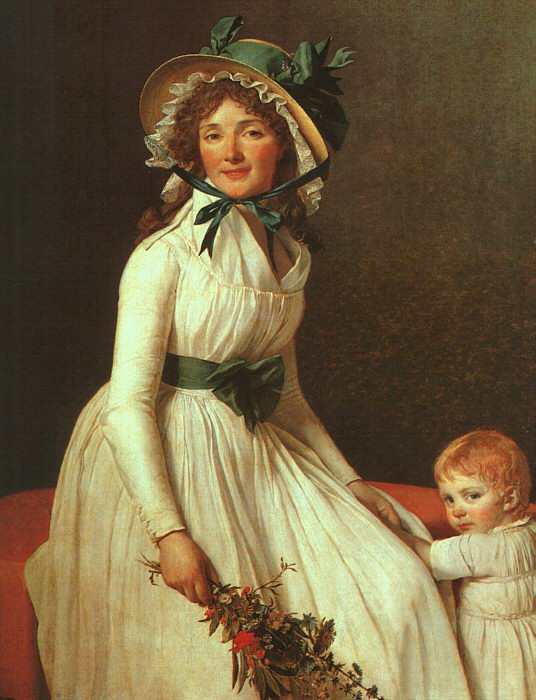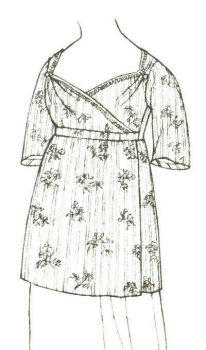All of my pattern designs were inspired by fashions of the past -- either by actual garments I've owned or seen in museum collections or by photographs, fashion plates, or illustrations (sometimes a combination of them all!). On this page I'm sharing the original sources for the patterns, including links to books and museum sites where applicable.
Original Regency Gown Pattern
This was my first design, which came out of my love for all things Jane Austen and several inspiring images I came across when I was sewing professionally in the mid-1990s. Here are the three main extant gowns which directly inspired this design:

This is a beautiful French empire evening gown which is also displayed on Cathy Decker’s Regency Fashion Site. The original gown is in the collection of the Metropolitan Museum of Art (CI 59.5). Note the gently squared neckline and slightly A-line skirt. What appealed to me so much about this particular gown was how modern the fit looked -- it doesn't have a costume-y look to it at all. With my first pattern design, I wanted to appeal to the Regency fans who would enjoy a more modern take on the era, and this dress was my answer, as was the one below.

This is an original woman’s day dress, circa 1810, which is on display in the Danish Museum. The fit of the dress also has a very modern flair to it, particularly when it comes to the shape of the skirt, which I love on this gown. While the neckline is ruffled, you can still see that softly squared shape that inspired my own design. If you click through to the museum's site, there is a long description in Danish. Translated roughly, it says that the gown was made between 1810 and 1820 and was for day wear. You'll see that the back view on the museum site shows the drawstrings used to close the gown. I added a drawstring to the neckline supplement for the Regency Gown pattern to provide yet another option for a period closure.

Here is the back view of a beautiful ca. 1815 gown from the McCord Museum in Canada (M15300). This gown inspired the undersleeve option for my pattern as well as the shape of the back neckline. This one closes with drawstrings similar to the way my neckline supplement works for the original Regency Gown pattern. If you click through to the museum's site, you can zoom in on the image and enjoy all the details.Finally, the back button closure comes from Nancy Bradfield's Costume in Detail: 1730-1930, page 101, plus several extant gowns I've viewed in museum collections but for which I do not own any photographs, unfortunately.
The Elegant Lady's Closet Pattern
I designed this pattern almost eight years after the original Regency Gown pattern, putting into it all the extra options and details I'd come to appreciate over the years of continued research. Both the drawstring gown and the crossover dress options were directly inspired by extant garments included in Janet Arnold's Patterns of Fashion I: 1660-1860 and by an original gown in the Valentine Museum Collection(which I photographed in 1999): The construction of the drawstring dress (including the waistline tie that goes through loops at the back) is shown on pages 48-49 & 52 of Patterns of Fashion I (though that version is a drop-front "round gown" with train):
The construction of the drawstring dress (including the waistline tie that goes through loops at the back) is shown on pages 48-49 & 52 of Patterns of Fashion I (though that version is a drop-front "round gown" with train): This image and Arnold's excellent graphed pattern pieces gave me the proper foundation for a drawstring dress with crossover lining beneath to smooth the line of the stays. Then I drew upon several favorite images to pull together a simple, yet elegant, drawstring dress design:
This image and Arnold's excellent graphed pattern pieces gave me the proper foundation for a drawstring dress with crossover lining beneath to smooth the line of the stays. Then I drew upon several favorite images to pull together a simple, yet elegant, drawstring dress design: This 1795 portrait by J. David shows the very full "chemise a la reine" of the time period. My drawstring dress isn't this full, but this portrait was definitely an inspiration. I love the simplicity and beauty of the gown.
This 1795 portrait by J. David shows the very full "chemise a la reine" of the time period. My drawstring dress isn't this full, but this portrait was definitely an inspiration. I love the simplicity and beauty of the gown. Here are Queen Luise and her sister, Frederika, of Denmark, wearing extremely simple, flowing drawstring gowns, accented at the empire waistline with ribbon sashes.
Here are Queen Luise and her sister, Frederika, of Denmark, wearing extremely simple, flowing drawstring gowns, accented at the empire waistline with ribbon sashes.

This is an original gown from the early Regency, accented with a delicate tulle overlay and featuring slim sleeves. Back when I sewed professionally, a customer sent me this photo so I could reproduce the dress, which was a really fun project. A customer found the provenance of this gown for me when I couldn't locate it: "The blue dress overlaid with tamboured tulle is from the Ethnographic Museum, The Hermitage, Leningrad (St. Petersburg), Russia. I have it in a book called The Art of Costume in Russia compiled by Tamara Korshunova Aurora Art Publishers, Leningrad 1979/1983." This gown inspired the overall look of my drawstring dress.The crossover gown inspiration came from a hip-length wrapper shown on pages 44-45 of Patterns of Fashion I: You can see the elbow-cupping shape of the sleeves, which I love from this time period. This garment has unique "tiebacks" just below the shoulders to create a more interesting neckline. You could easily do this with my pattern as well with buttons and thin cording or ribbon.I was also inspired by a few other extant garments and fashion plates:
You can see the elbow-cupping shape of the sleeves, which I love from this time period. This garment has unique "tiebacks" just below the shoulders to create a more interesting neckline. You could easily do this with my pattern as well with buttons and thin cording or ribbon.I was also inspired by a few other extant garments and fashion plates:
 1804 Crossover Gown, featured in Jane Ashelford’s Book, The Art of Dress: Clothes and Society 1500-1914, which is a gorgeous pictorial history of fashion as a cultural barometer.
1804 Crossover Gown, featured in Jane Ashelford’s Book, The Art of Dress: Clothes and Society 1500-1914, which is a gorgeous pictorial history of fashion as a cultural barometer.
MORE SOURCES COMING SOON!


